Thoracic Aortic Aneurysm
The aorta is the body’s largest artery, running from the heart through the chest (thoracic aorta) and abdomen. A thoracic aortic aneurysm (TAA) is a bulge or weakening in the wall of the aorta as it passes through the chest. This can lead to life-threatening complications if it grows or ruptures.
Thoracic aortic aneurysms develop when a section of the main artery in the chest becomes weakened. This weakening causes the arterial wall to expand beyond its normal diameter.
Common Symptoms of Thoracic Aortic Aneurysm
TAAs often develop slowly and without symptoms. Many never grow large enough to show symptoms. As they grow, they may cause:
Chest or back pain
Cough or hoarseness
Shortness of breath
Difficulty swallowing
Symptoms of a ruptured or dissected aneurysm may include:
Sudden, severe chest or back pain
Low blood pressure
Fainting or loss of consciousness
Trouble breathing and swallowing
It’s important to note that some aneurysms may never rupture or lead to dissection.
Causes
Common causes of thoracic aortic aneurysms may include:
- Atherosclerosis: The most common cause is atherosclerosis, a condition in which fatty deposits, cholesterol, and other substances build up on artery walls. This can lead to weakening and bulging of the artery.
- Genetic conditions: Genetic disorders are a major cause in younger individuals. Conditions like Marfan syndrome, Loeys-Dietz syndrome, and vascular Ehlers-Danlos syndrome affect connective tissue and can significantly weaken the aortic wall, increasing the risk of aneurysm, dissection, or rupture.
- Blood vessel inflammation: Autoimmune conditions such as Takayasu arteritis and giant cell arteritis can damage and inflame arteries, including the aorta, making them more vulnerable to aneurysm formation.
- Bicuspid aortic valve: A bicuspid aortic valve is a congenital heart defect where the aortic valve has only two flaps instead of the normal three. This abnormal structure puts extra stress on the aorta, especially as a person ages.
- Untreated infection: Though rare, untreated infections like syphilis or salmonella can affect the aortic wall and lead to aneurysm development if not properly managed.
Risk factors
Several factors can increase the likelihood of developing a thoracic aortic aneurysm, particularly those that damage or weaken blood vessels over time. These include:
- Age: Age is a primary risk. Most cases occur in people over 65.
- Smoking and tobacco use: Smoking and using other tobacco products significantly raise the risk, as they damage arteries and accelerate aneurysm growth.
- High blood pressure: Increased blood pressure puts extra strain on artery walls, making them more prone to bulging.
- Coronary artery disease: Atherosclerosis (or narrowing of the arteries due to fatty deposits) damage the wall of a blood vessel, especially in older adults.
- Family history: A family history of aortic aneurysms increases risk at a younger age, particularly if a parent or sibling has had one.
People with known risk factors may be prescribed medications to reduce blood pressure and stress on the aortic wall, lowering the risk of aneurysm growth or rupture.
Diagnosis
Thoracic aortic aneurysms are often discovered incidentally during imaging tests done for other reasons. A routine chest X-ray may reveal a widened mediastinum, prompting further investigation. If a provider suspects an aneurysm, more precise imaging will be ordered, such as:
- CT angiogram
- Echocardiogram (echo)
- Magnetic resonance angiogram (MRA)
- Abdominal ultrasound (to check for additional aneurysms)
People with a family history of aneurysms or genetic conditions like Marfan syndrome may need routine screening. If an aneurysm is detected, repeat imaging every 6 to 12 months is often recommended to monitor for changes.
Prevention
While not all aneurysms are preventable, you can reduce your risk by protecting your blood vessels:
- Quit smoking and avoid tobacco use
- Control blood pressure and cholesterol levels
- Maintain a healthy weight
- Stay physically active
- Eat a heart-healthy diet
These lifestyle choices help keep arteries strong and reduce stress on the aortic wall.
Treatment options
Treatment depends on the size, location, and growth rate of the aneurysm.
- Small, stable aneurysms may only require regular monitoring and medications to manage blood pressure.
- Larger or fast-growing aneurysms often need surgical intervention to prevent rupture or dissection, both of which can be fatal.
Surgical Treatments:
- Open Surgery: Involves removing the damaged portion of the aorta and replacing it with a synthetic graft. This approach is used for complex or ascending aortic aneurysms.
- TEVAR (Thoracic Endovascular Aortic Repair): A less invasive procedure where a stent graft is delivered through a small incision near the groin to reinforce the aorta. TEVAR is often preferred due to its shorter recovery time and lower complication risk.
- Aortic Root Replacement: For aneurysms near the heart, this surgery may also involve replacing the aortic valve or using valve-sparing techniques when possible.
Your vascular specialist will recommend the most appropriate treatment based on your condition and anatomy.
How does aneurysm treatment work at RIVEA?
TEVAR (Thoracic Endovascular Aortic Repair):
At RIVEA, Dr. Karthik Mikkineni performs TEVAR using a needle-hole access instead of even a small incision. A stent graft is carefully guided through a blood vessel to the weakened part of the thoracic aorta, reinforcing it from within. Unlike traditional open surgery that required long hospital stays, our patients are often discharged in less than 24 hours.
Why RIVEA?
RIVEA is dedicated to advanced vascular, endovascular, and interventional radiology treatments. Led by Dr. Karthik Mikkineni, an internationally recognized American Board of Surgery–certified vascular and endovascular surgeon, our vascular department specialises in both minimally invasive and open procedures for complex vascular conditions. With over 500 advanced aortic procedures performed, Dr. Mikkineni brings global expertise and innovation to patient care, ensuring safer treatments and faster recoveries.
What RIVEA offers:
- Advanced imaging technology for highly targeted treatment
- American Board–certified vascular surgeon and specialist in FEVAR, branched aortic grafts, EVAR, TEVAR, and open aortic surgery
- Personalized consultations and tailored care plans
Early diagnosis can be life-saving. If you have a family history or risk factors for aortic aneurysms, schedule a screening with RIVEA Vascular Institute.
Click here to learn more about:
Thoracic Endovascular Aortic Repair (TEVAR)
For any inquiries, post your query here:
Ask Rivea
Contact us today to explore your options.
Call Now
Our Team
-

Dr. Karthik Mikkineni
MD, FACS, FSVS, RPVI
Dr. Karthik Mikkineni is an internationally recognized vascular and endovascular surgeon, known for his pioneering work in complex aortic interventions, limb salvage, and carotid disease management.
View Profile Book an Appointment



